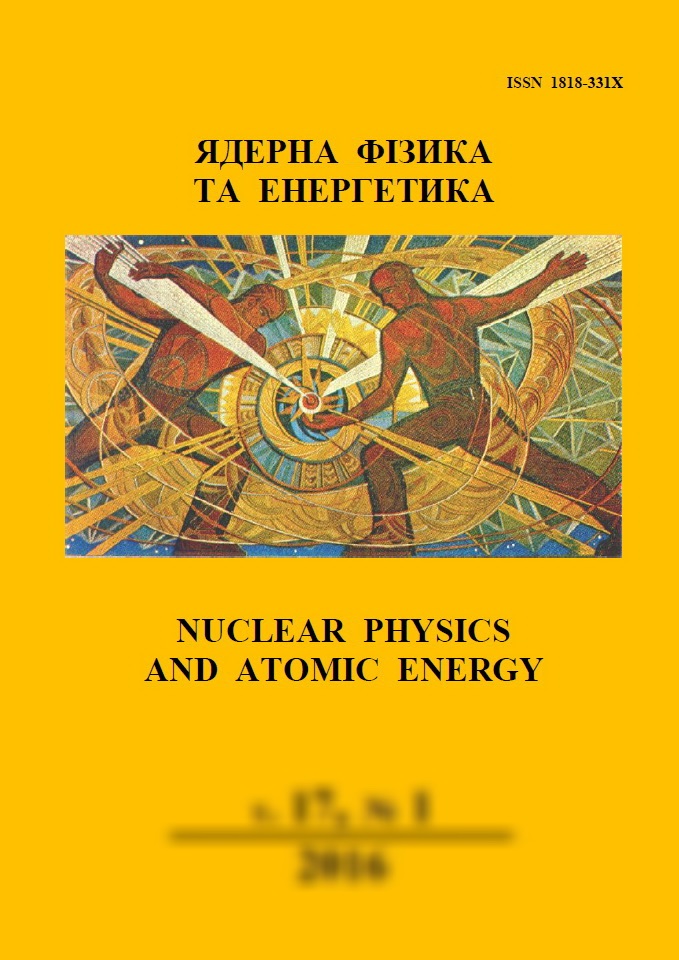 |
Ядерна фізика та енергетика
Nuclear Physics and Atomic Energy
ISSN:
1818-331X (Print), 2074-0565 (Online)
Publisher:
Institute for Nuclear Research of the National Academy of Sciences of Ukraine
Languages:
Ukrainian, English
Periodicity:
4 times per year
Open access peer reviewed journal
|
Nucl. Phys. At. Energy 2009, volume 10, issue 1, pages 45-49.
Section: Nuclear Physics.
Received: 09.06.2008; Published online: 30.03.2009.
 Full text (en)
Full text (en)
https://doi.org/10.15407/jnpae2009.01.045
Competition of break-up and dissipative processes in peripheral collisions at Fermi energies
T. I. Mikhailova1, A. G. Artyukh1, M. Colonna2, M. Di Toro2, B. Erdemchimeg1,3, G. Kaminski1,4, I. N. Mikhailov1, Yu. M. Sereda1,5, H. H. Wolter6
1Joint Institute for Nuclear Research, Dubna, Moscow region, Russia
2Laboratori Nazionali del Sud, Istituto Nazionale di Fisica Nucleare, Catania, Italy
3Mongolian National University, Nuclear Research Center, Ulaanbaatar, Mongolia
4Institute of Nuclear Physics PAN, Krakow, Poland
5Institute for Nuclear Research, National Academy of Sciences of Ukraine, Kyiv, Ukraine
6Faculty of Physics, University of Munich, Garching, Germany
Abstract:
Heavy ion collisions in the Fermi energy regime may simultaneously show features of direct and dissipative processes. To investigate this behavior in detail, we study isotope and velocity distributions of projectile-like fragments in
the reactions 18O (35 MeV/A) + 9Be(181Ta) at forward angles. We decompose the experimental velocity distributions
empirically into two contributions: a direct, 'break-up' component centered at beam velocity and a dissipative component at lower velocities leading to a tail of the velocity distributions. The direct component is interpreted in the Goldhaber model, and the widths of the velocity distributions are extracted. The dissipative component is then successfully
described by transport calculations. The ratio of the yields of the direct and the dissipative contributions can be understood from the behavior of the deflection functions. The isotope distributions of the dissipative component agree qualitatively with the data, but the modification due to secondary de-excitation needs to be considered. We conclude that
such reactions are of interest to study the equilibration mechanism in heavy ion collisions.
References:
1. Veselsky M. et al. Heavy residues with A < 90 from
the asymmetric reaction of 20 AMeV 124Sn + 27Al as a
sensitive probe of the onset of multifragmentaion. Nucl. Phys. A 724 (2003) 431.
https://doi.org/10.1016/S0375-9474(03)01571-9
2. Kaminski G. et al. Analysis of production of forward-angle fragments in the 22Ne(40 MeV) + 9Be reaction. Nucl. Phys. and Atom. Energy 9 (2008) 39.
https://jnpae.kinr.kyiv.ua/25(3)/Articles_PDF/jnpae-2008-3(25)-0039-Kaminski.pdf
3. Gelbke C. K. et al. Influence of intrinsic nucleon motion on energy spectra and angular distributions for 16O-induced reactions at 20 MeV/A. Phys. Lett. B 70 (1977) 415.
https://doi.org/10.1016/0370-2693(77)90402-6
4. Lahmer W. et al. Transfer and fragmentation reactions
of 14N at 60 MeV/u. Z. Phys. A 337 (1990) 425;
https://doi.org/10.1007/BF01294980
Bacri Ch. O. Measurements in the beam direction of the 40Ar projectile fragmentation at
44 MeV/A. Nuc. Phys. A 555 (1993) 477.
https://doi.org/10.1016/0375-9474(93)90297-B
5. Borrel V. et al. Peripheral Ar induced reactions at 44
MeV/u - similarities and deviations with respect to a
high energy fragmentation process. Z. Phys. A 73 (1983) 191.
https://doi.org/10.1007/BF01879877
6. Notani M. et al. Projectile fragmentation reactions and
production of nuclei near the neutron drip line. Phys.
Rev. C 76 (2007) 044605.
https://doi.org/10.1103/PhysRevC.76.044605
7. Goldhaber A. S. Statistical model of fragmentation
processes. Phys. Lett. B 53 (1974) 306.
https://doi.org/10.1016/0370-2693(74)90388-8
8. Schröder U., Huizinga J. R. Damped nuclear reactions. Treatise on Heavy-Ion Science. Vol. 2. Ed. by A.
Bromley (New York: Plenum, 1984) p. 113.
9. Mikhailova T. et al. Investigation of dissipative collisions with transport models. Rom. Journ. Phys. 52 (2007) 875.
10. Mikhailova T. et al. Description of deep inelastic transfer reactions at the Fermi energy within transport models. Bull.
of the Russian Academy of Sciences. Phys. 72 (2008) 339.
https://doi.org/10.3103/S1062873808030155
11. Artukh A. G. et al. QMD approach in the description of
the 18O + 9Be and 18O + 181Ta reactions at Eproj = 35 AMeV. Acta Physica Polonica B 37 (2006) 1875.
12. Rivet M. F. et al. Dynamical aspects of violent collisions in Ar + Ag reactions at E/A = 27 MeV. Phys. Lett. B 215 (1988) 55.
https://doi.org/10.1016/0370-2693(88)91069-6
13. Artukh A. G. et al. Some regularities in the beam-direct
production of isotopes with 2⩽Z⩽11 induced in reactions of 18O (35 A MeV) with Be and Ta. Nucl. Phys.
A 701 (2002) 96.
https://doi.org/10.1016/S0375-9474(01)01554-8
14. Bertsch G. F., Das Gupta S. A guide to microscopic
models for intermediate energy heavy ion collisions. Phys. Rep. 160 (1988) 189.
https://doi.org/10.1016/0370-1573(88)90170-6
